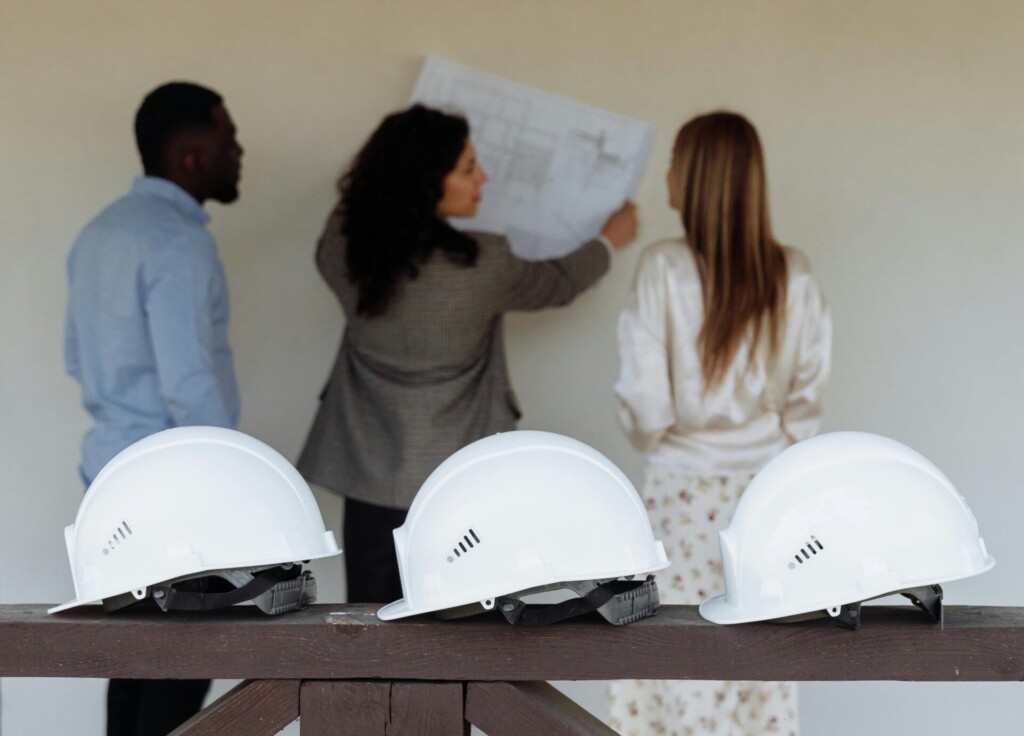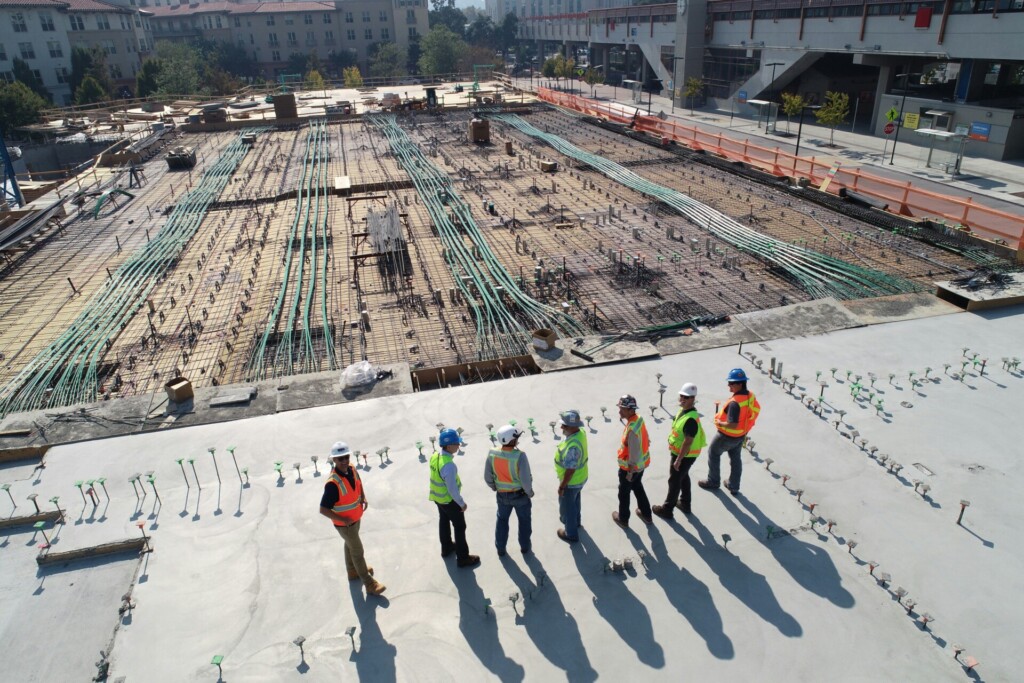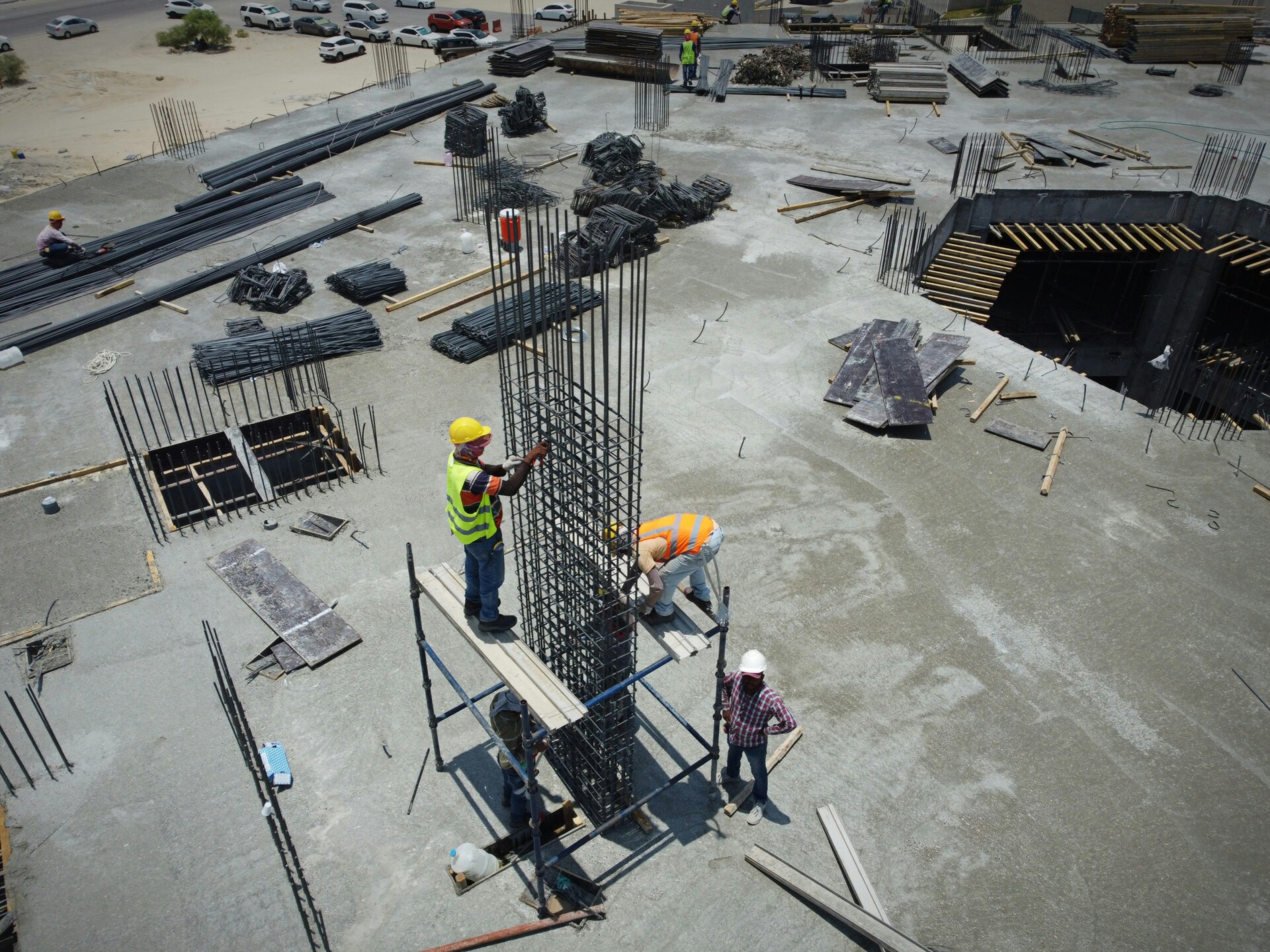Traditional construction means juggling two separate contracts, two teams, and endless coordination meetings. A design build general contractor eliminates that complexity by delivering both design and construction under a single contract.
This project delivery method gives owners one point of contact for their entire project. We coordinate architects, engineers, and subcontractors from day one, streamlining collaboration and reducing the finger-pointing that often derails construction schedules. The owner defines project goals and maintains approval authority while our integrated team handles execution from feasibility through closeout.
What Responsibilities And Risks Does A Design-Build General Contractor Assume?

Under design-build delivery, we assume responsibility for the majority of design work alongside all construction activities. This comprehensive role means we handle architectural and engineering coordination, construction execution, and project integration under a fixed fee contract structure. The design-builder carries the risks associated with both design adequacy and construction performance.
Owners typically retain responsibility for project financing, operations, and long-term maintenance once we complete construction. We manage design coordination, contractor supervision, and subcontractor relationships. The owner defines project goals, provides approvals during key phases, and maintains oversight of the overall direction while we execute the technical work.
Risk Allocation And Liability
The design-build model shifts considerable project risk from the owner to us as the constructor. We accept liability for design errors, construction defects, and coordination issues between design and building phases. Cost overruns beyond the agreed fixed fee become our responsibility, not the owner’s.
This risk transfer includes material price volatility, labor availability, and schedule delays within our control. Weather-related delays, site conditions differing significantly from initial assessments, or owner-directed changes typically remain shared risks or revert to the owner depending on contract terms.
Accountability And Communication
We serve as the single point of accountability for project delivery. This means owners communicate directly with us rather than managing separate relationships with architects and contractors. Information sharing improves because our design and construction teams collaborate from project start rather than working in isolated phases.
The unified team structure reduces blame-shifting between designers and builders. When issues arise, we address them internally and present solutions to the owner rather than creating adversarial relationships between separate design and construction contracts.
Team Selection Implications
The comprehensive responsibility we assume makes team selection critical for owners. They must choose a design-build contractor with proven experience in similar projects, strong communication capabilities, and collaborative working relationships. Our ability to integrate design professionals, manage subcontractors, and coordinate complex project elements directly impacts project success.
Owners lose some direct control over individual design decisions in exchange for streamlined project delivery. They rely on our professional judgment and expertise to balance design intent with construction feasibility and cost management throughout the project lifecycle.
How Does The Design-Build Process Work From Concept To Closeout?
The design-build approach follows a structured sequence that allows design and construction work to overlap. We coordinate these phases to maintain project momentum while ensuring quality control throughout. Each step builds on the previous one, creating a seamless workflow from initial site evaluation to final handover.
Site Selection And Due Diligence
Site evaluation begins with comprehensive due diligence that examines zoning compliance, surveying requirements, and geotechnical conditions. We assess environmental factors that could impact construction feasibility or require special permits. This early investigation prevents costly surprises during later phases and ensures the selected site can support the intended development within regulatory constraints.
Proper site analysis includes evaluating access routes for construction equipment, utility availability, and soil conditions that affect foundation design. We coordinate with environmental consultants to identify any wetlands, endangered species habitats, or historical significance that could trigger additional approval processes. These findings directly influence our design approach and construction methodology.
Project Conception And Feasibility
We work with owners to establish project scope, preliminary budgets, and realistic schedules during the feasibility phase. This collaborative process helps define what can realistically be achieved within the owner’s parameters. We evaluate multiple design concepts to determine which approach best balances cost, schedule, and performance requirements.
Feasibility studies examine constructability issues that traditional design-bid-build projects often discover too late. Our construction teams provide input during this early phase, identifying potential challenges and opportunities that shape the final project approach. This integration prevents the disconnect between design intent and construction reality that plagues many projects.
Preliminary Design And Cost Estimating
Building Information Modeling and Virtual Design and Construction technologies enable more accurate early estimates. We develop preliminary designs that incorporate construction input from the start, ensuring buildability while meeting performance requirements. BIM coordination allows us to identify conflicts before they become field problems.
Cost estimating during this phase relies on real-time material and labor data rather than historical assumptions. We leverage relationships with subcontractors and suppliers to validate pricing assumptions. This collaborative estimating process produces more reliable budgets than traditional methods that separate design from construction expertise.
Selecting The Design-Build Team
The procurement process includes interviews and presentations that reveal how teams will collaborate and communicate throughout the project. We present our integrated approach, showing how our design and construction professionals work together from day one. This transparency helps owners understand exactly what they’re purchasing and who will be accountable for results.
Design Phase Implementation
Performance requirements drive our design development rather than prescriptive specifications. We establish shared goals between owner, design team, and construction team early in this phase. Regular design meetings include construction input to maintain constructability and cost control as designs mature.
Early schedule and budget development happens concurrently with design progress. We provide continuous feedback on how design decisions impact cost and schedule, allowing real-time adjustments. This integrated approach prevents the costly redesign cycles common in traditional delivery methods.
Contract Finalization
Contract negotiations focus on finalizing scope, schedule, and cost based on developed designs. We work with owners to establish clear change management processes and communication protocols. The contract defines roles, responsibilities, and decision-making authority for all parties involved in project delivery.
Fixed-price contracts become possible because we’ve been involved in design development and understand actual construction requirements. Risk allocation reflects our integrated responsibility for both design and construction performance. This clarity reduces disputes and creates accountability for project success.
Construction Execution
Construction management involves coordinating subcontractors, daily field operations, and progress reporting through our single point of contact. We handle all construction activities while maintaining the design team’s involvement for clarifications and approvals. This integrated approach eliminates the finger-pointing common when design and construction are separate.
Daily project management includes monitoring quality, safety, schedule, and budget simultaneously. We provide regular updates to owners through established communication channels, maintaining transparency throughout construction. Our teams resolve issues quickly because we control both design and construction resources.
Project Closeout And Documentation
Closeout documentation remains centralized with our team since we’ve managed both design and construction phases. We compile all project records, warranties, operation manuals, and as-built drawings into comprehensive handover packages. This centralized approach streamlines the closeout process compared to coordinating between separate design and construction entities.
Post-construction review examines project performance against original goals and identifies lessons learned for future projects. We maintain ongoing relationships with owners for warranty service and potential future work. Our integrated delivery approach often results in higher owner satisfaction and repeat business opportunities.
Procurement Guidelines For Owners
Owners should provide sufficient project definition to enable effective procurement while avoiding over-specification that limits innovation. In highway projects, preliminary design completion of 10 to 15 percent often provides adequate definition for design-build procurement. This level allows teams to understand project requirements without constraining their approach to achieving those goals.
Effective procurement balances owner control with team flexibility. We recommend owners focus on performance requirements and project outcomes rather than prescriptive methods. This approach allows design-build teams to leverage their expertise while ensuring owner objectives are met within established parameters.
How Does Design-Build Compare To Traditional General Contracting (Design-Bid-Build)?

When we evaluate construction approaches, the fundamental differences between design-build and traditional design-bid-build create distinct advantages and challenges for owners and developers. Both methods serve the same goal of completing construction projects, but they take markedly different paths to get there.
Structural Framework
Design-build operates through a single contract that covers both design and construction phases. This creates one point of contact between the owner and the project team. The design-builder assumes responsibility for coordinating architects, engineers, and construction personnel under unified management.
Design-bid-build maintains separate contracts for the architect and the general contractor. The owner manages relationships with both parties independently. This traditional approach requires the owner to coordinate between design and construction teams who may have different priorities and timelines.
Speed And Cost Control Performance
Project delivery speed shows significant differences between these approaches. Design-build can deliver projects up to 102% faster than design-bid-build due to overlapping design and construction phases. The integrated teams can begin preliminary construction activities while design work continues on later phases.
Cost growth patterns also vary substantially. Design-build projects typically experience about 3.8% less cost growth compared to design-bid-build. The unified approach allows for real-time cost feedback during design development, reducing expensive changes later in the process.
Design-bid-build often requires redesign and rebid cycles when initial bids exceed budget expectations. These cycles extend project timelines and can increase costs through market escalation and extended design fees.
Communication And Risk Management
Communication flows differ significantly between the two methods. Design-build improves coordination and transparency because design and construction teams align under shared project goals. Information sharing improves when teams work toward common objectives rather than protecting separate contractual interests.
The design-builder carries substantially more project risk in the integrated approach. This includes design errors, construction defects, and schedule delays. For owners, this means clearer accountability but requires careful selection of qualified design-build teams.
Design-bid-build can increase miscommunication opportunities with the owner acting as an intermediary between designer and contractor. When issues arise, determining responsibility between separate contracts can create delays and disputes.
Strategic Trade-Offs
Design-build offers greater efficiency and more consistent budgeting throughout the project lifecycle. However, owners may perceive less creative control over design decisions. Initial pricing may appear higher without traditional competitive bidding rounds, though total project costs often prove lower.
Design-bid-build provides competitive bidding opportunities that can drive down initial construction costs. Owners maintain more direct control over design development and can make changes before construction begins. However, this approach carries higher risks of delays, change orders, and coordination issues between separate teams.
The choice between these approaches depends on project complexity, schedule requirements, and the owner’s risk tolerance. We find that design-build works well for owners who prioritize speed and integrated delivery, while design-bid-build suits those who prefer direct oversight of separate design and construction phases.
What Should Owners Evaluate When Choosing A Design-Build General Contractor And What Belongs In The Contract?
Selecting the right design-build general contractor requires careful evaluation of team capabilities and clear contract provisions. The decision impacts project delivery from initial design through final closeout.
Team Selection Criteria
Prior similar project experience provides the foundation for evaluating potential design-build partners. We look for teams that have successfully completed projects of comparable scope, complexity, and budget. This experience demonstrates their ability to navigate the specific challenges that arise during integrated project delivery.
Communication and collaboration capabilities across design and construction disciplines distinguish effective design-build teams. The ability to facilitate seamless information flow between architects, engineers, and construction professionals directly impacts project outcomes. Teams should demonstrate how they integrate these traditionally separate functions under unified project leadership.
Technology integration through Building Information Modeling (BIM) and Virtual Design and Construction (VDC) capabilities enhances project coordination and reduces conflicts. Evaluate how teams leverage these tools to improve design accuracy, construction sequencing, and stakeholder communication. Their approach to working with subcontractors through these platforms shows their commitment to integrated project delivery.
Best-value procurement considers qualifications, technical approach, and cost together rather than focusing solely on lowest price. This selection method aligns with design-build’s emphasis on integrated solutions and long-term value. Price-only selection can compromise the collaborative relationships essential to successful design-build delivery.
Essential Contract Elements
Risk assessment and allocation provisions clearly define which party assumes responsibility for various project risks. The contract should address design liability, construction performance, schedule adherence, and cost control. Clear risk allocation prevents disputes and ensures appropriate contingencies are maintained throughout the project.
Change management processes establish procedures for handling scope modifications, unforeseen conditions, and owner-requested alterations. The contract should define approval thresholds, documentation requirements, and cost impact procedures. Well-defined change management prevents project delays and budget overruns.
Communications plans specify reporting relationships, meeting schedules, and information exchange protocols. The contract should identify who provides updates to whom, when reports are delivered, and how decisions are communicated to the project team. Clear communication requirements support the single point of contact advantage that design-build provides.
Roles, responsibilities, and milestones define each party’s obligations throughout project phases. The contract should specify the owner’s role in design approvals, permit processes, and construction oversight. Milestone definitions provide measurable checkpoints for evaluating project progress and triggering payment schedules.
Implementation Considerations
Adequate preliminary project definition before procurement ensures all parties understand scope boundaries and performance expectations. Insufficient definition leads to disputes over what constitutes the baseline project scope. Clear project criteria enable meaningful RFP responses and fair team evaluation.
Progressive design-build provides flexibility when project definition remains uncertain or when owners prefer phased commitment. This approach allows an “off-ramp” if agreement cannot be reached during the design phase. Progressive delivery works particularly well when scope, schedule, or budget parameters may evolve as design progresses.
Conclusion And Next Steps

Design-build delivery fundamentally changes how we approach construction by placing both design and building responsibilities under one unified contract. This streamlined approach gives property owners a single accountable partner throughout the entire project lifecycle. The benefits center on faster delivery, clearer communication channels, and more predictable risk management compared to traditional methods where owners must coordinate between separate design and construction teams.
Moving forward with design-build requires deliberate planning and strategic decisions. Focus on value-based selection when choosing your design-build team rather than simply accepting the lowest bid. Strong contract terms should clearly define scope boundaries early in the process, establish transparent change management procedures, and outline communication protocols. Consider progressive design-build for complex projects where an off-ramp option provides additional flexibility during the design phase, allowing you to reassess before committing to construction costs.
Ready to explore design-build delivery for your next project? Contact EB3 Construction to discuss how we can streamline your project from feasibility through closeout.




